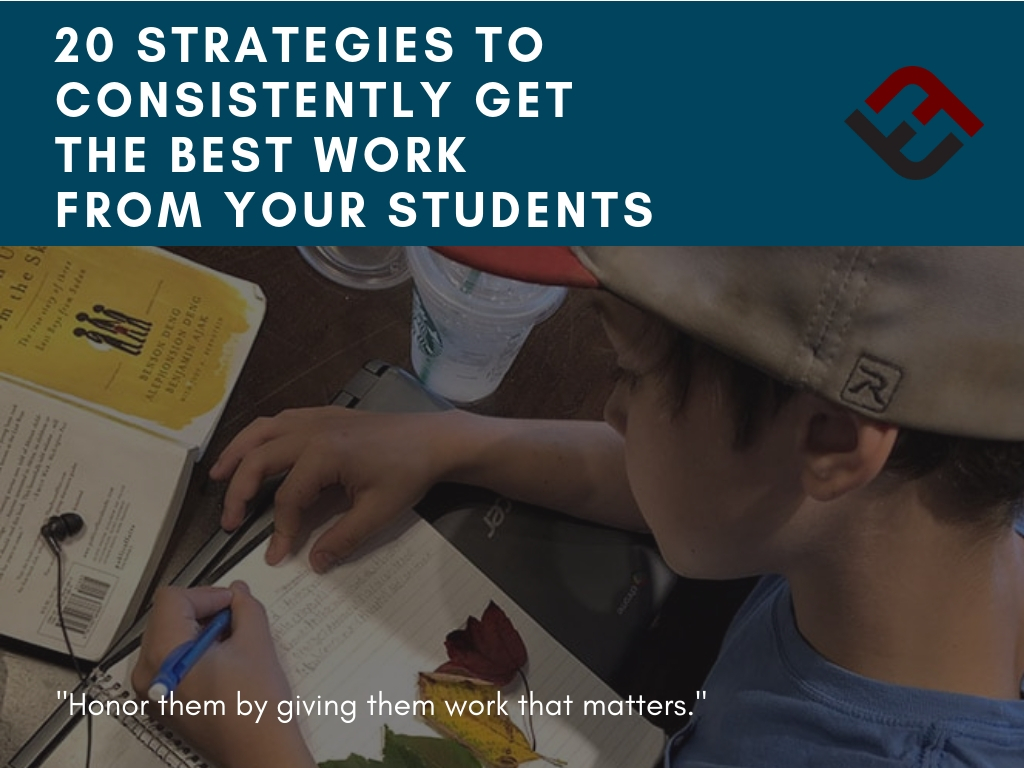
What Are The Best Strategies To Get The Best Work From Your Students?
by Terry Heick
Consistently getting the best work from your students is at the core of great teaching.
Typical strategies for getting the best work from students focus on extrinsic motivation and gamification—points, grades, badges, certificates, stars, trophies, glowing feedback, encouragement, pep talks, ‘pressure,’ and other ways to motivate students. That these strategies are underwhelming in effect–and tend to not yield the life-long learners education seeks to create–shouldn’t be surprising.
Below, I’ve offered 20 strategies for getting the best work from your students. Some are obvious (provide student choice) and many you may already do. The idea here is to clarify the kinds of teaching practices and learning strategies that give your students the best chance to do their best–to consistently do their very best work, and grow the most as students over the course of a school year.
Helping Students Do Their Best: 20 Strategies To Get The Best Work From Your Students
1. Give them authentic voice & choice
To get the best work from students, authentic ‘voice and choice’ matter and a big part of this is leaving ‘room for interpretation’ in the assignment. Those gray areas can confuse students unaccustomed to agency and choice, but once they become comfortable with it, it can be a significant factor in helping them show what their ‘best’ actually is.
At the end of the day, students can’t become ‘great’ by duplicating your thinking and fulfilling your sense of priority. It has to not just involve them but depend on their own genius and effort. In Teaching Disruptively, I said:
“Teaching disruptively, then, has nothing to do with you. You’ll know it when you’ve found it because it won’t suggest ‘disruption’ at all. Instead, you’ll see the rising of a kind of slow ash—of new ideas that aren’t always packaged how you asked, and don’t always do what you want them to do.”
Which makes helping students believe in themselves a clear first step. To complicate matters, the students who need that kind of bolstering may not be the ones you suspect. Some students who ‘struggle’ do so extrinsically–meaning that their belief in themselves is strong but their belief in the outward circumstance (like your classroom or a specific assignment within in it) may not be.
Further, like adults, a child’s confidence can appear strong but be either fragile or contextual–highly-dependent on a narrow set of circumstances that can disappear quickly–and take that ‘confidence’ with them.
2. Help them see
To get the best work from students, help them see. See what they’re doing and why. See what others have done and how. See what’s possible.
Help them to see what’s possible in the assignment, how the work can benefit them, and most crucially that they’re capable of doing that important work and that you’re there for them when they waver.
2. Help them create their own standards for quality
They won’t naturally know how to do this in academic work but do it constantly in how they dress, speak to one another, play games, interact socially, and so on. To get the best academic work from a student, ideally they will learn to create their own standards for quality academic work–ideally alongside you, as a teacher.
Rubrics and scoring guides can help here as well.
3. Start and end with their genius and gifts.
And this includes the gifts and resources from their family—baking if they own a bakery, construction if they work in construction…
4. Revisit ‘old’ work
Keep a portfolio of their best work–physical or digital or both. Public and social or private and just between you and them–then use these bits and pieces to identify gaps, find inspiration, pivot for new applications, or simply improve in terms of quality, accuracy, etc.
5. Let them see expert models
If they’re building a bridge, to get the best from them help them see expert bridge-building. If they’re going to sing or paint or write or act or excavate or farm or direct, let them see what the most passionate, driven, and skilled people in those fields do.
Then help them do it, too.
6. Give them personalized feedback
Personalized feedback means the right feedback (see #7 below) at the right time (this one can be tricky) in the format, tone, and duration that works for that student.
Whether they’re taking a test, finishing a project, or doing something entirely out-of-the-box, the more precise, well-timed, and thoughtful the learning feedback, the better chance they have to do their best work. Giving learning feedback is easy, but giving learning feedback that actually improves student work is another thing entirely.
(See Just In Time, Just Enough, Just For Me.)
7. Teach diagnostically
Think cause-effect…
When they don’t understand the assignment (cause), they don’t ask the right questions about the assignment that will help them (effect).
When they have too much work in other classes (cause), they rush their work, are prone to errors, and don’t show much vision or creativity in what they do (effect).
So you have to think in terms of causes and effect–sometimes through a kind of diagnostic teaching.
Is it confidence?
Is it a skill?
Is it a knowledge gap? Temporary apathy?
Just too early in the morning for that kind of thinking?
A big part of this is being able to, as a teacher, separate skills, competencies, and knowledge necessary to complete high-quality work on an assignment-by-assignment basis.
Obviously, the background knowledge and skills need to be there in order for certain ‘things’ to be done. If they can’t use idea organization strategies, writing compelling essays is going to be difficult. If the essay isn’t ‘their best,’ you have to figure out why it’s not their best–and not all students. That student standing in front of you.
The answer is usually framed as a class (e.g., ‘They struggle using transitional phrases) when in reality, though that might be true, there are either bigger problems–or other problems further upstream (like not fully understanding the point of the essay) that make their lack of transitional phrases in their essay an effect rather than a cause. That is, they don’t fully understand what they’re writing about and why, so they struggle to create a compelling argument in writing (which means they don’t use transitional words and phrases as naturally).
Seeing this, you go back and give them a mini-lesson on transitions because that’s what they’re missing. And while you’re not wrong, you’re missing why *they* are ‘wrong’ and so will be less likely to help them.
And you’ll be less likely to see improvement in student learning as a result.
8. Clarify and emphasize the purpose
If they don’t know exactly what they’re doing and why, it’s hard for them to care–and if they don’t care, you can forget about getting their best work.
9. Use rubric designed for quality, not ‘scoring’
First, know the difference between a scoring guide and a rubric–then design a rubric that actually supports students in learning more and doing their best work in your classroom.
10. Let them see models from other students
While work from experts is useful in one way, work from peers can often have more credibility with some students. There are many reasons for this, from confidence and competitiveness to audience and self-efficacy. Just know that parents motivate students one way, their peers another, teachers another, and so on. We all have different things that move us for different reasons, and students are no different.
10. Get the school out of it
The more something ‘smells like school,’ the less likely it is to get the very best genius from a student. That doesn’t mean it’s impossible, but students–especially by late middle school into high school and college–think of school differently than teachers and parents do.
The more personal and authentic their reason for learning, the better the chance you’ll see the very best performance from that student.
11. And get it out of the school
Whether you’re ‘publishing in the real world,’ using place-based education through project-based learning, connecting a high school student with a university, a middle school student with a content area expert, or any other reason, the more likely the work has a legitimate reason to ‘leave the school,’ the more motivated many students can be to give their best.
12. Spiral the big, important ideas in your curriculum
In 5 Simple Ideas That Can Transform Your Teaching, I said to ‘constantly spiral the most important, most transferable big ideas in your content.’ This is partly because those ‘big ideas’–assuming they’re sufficiently big–take a while to grasp and require a variety of different learning approaches to master.
But these same big ideas are (ideally) actually useful to for students to know and be able to ‘do’ in the execution of work that is inspiring, authentic, published, and connected to other things they care about.
13. Break big stuff into little stuff.
Take one of those big ideas and break it down into smaller ideas (this is often part of ‘unpacking standards’). The less overwhelming the work is–and the more frequently students can work on these smaller bits that often end up as part of the fundamentals of the big ideas–the more likely the students will learn more, then actually use what they learned.
14. Start with emotion.
And end there, too. (See below.)
15. Make curiosity, joy, and passion consistent ‘currencies’ in your classroom
Give them points for joy and passion. Don’t like that approach? Model it. Praise it. Help students praise it when they see it in one another.
16. When possible, make ‘design’/design thinking an integral part of the assignment
…or at least make elements of design thinking impact critical parts of that assignment. You’ll know this is working when you see the same assignment produce very different results from different students.
17. Use metacognition before, during, and after important assignments
What are you thinking about this assignment? How did that thought make you feel? What did it remind you of? When do you do your best kind of thinking in these situations? Now that you’ve turned your assignment it, in hindsight when were you ate your best and why?
18. Help them care–get the attention of your students and don’t let it go
Want better work from students? Get their attention and keep it.
Make it fun. Add music or video games. Go outside. Make it ‘controversial’ somehow. Go outside.
Note, this can backfire and distract from the whole point of the assignment–use it intentionally and thoughtfully. Use the ‘fun’ as a backdrop for the experience, not the other way around.
19. Design the learning to last
Whether through 40/40/40. PBL, place-based education, etc., design work for students that will last–something they’ll want to keep for years, that will function in their family or community for years, that’s worth curating in a portfolio for college, etc.
Honor them by giving them work that matters.
20. Change the grade if the quality of the work changes
To get the best work from students, be willing to regrade work at any time while doing your best to, insofar as you are able, to get the ‘grading’ out of the assignment. (Or at least be willing to add points for specific improvements, or let them revise and reflect on their impact of those revisions and give points for that if you’re pressed for time.)
